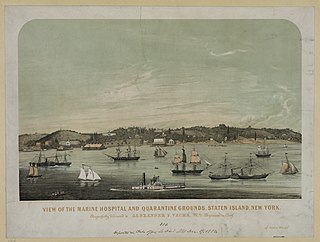
A quarantine is a restriction on the movement of people, animals and goods which is intended to prevent the spread of disease or pests. It is often used in connection to disease and illness, preventing the movement of those who may have been exposed to a communicable disease, yet do not have a confirmed medical diagnosis. It is distinct from medical isolation, in which those confirmed to be infected with a communicable disease are isolated from the healthy population. Quarantine considerations are often one aspect of border control.

The 1978 smallpox outbreak in the United Kingdom resulted in the death of Janet Parker, a British medical photographer, who became the last recorded person to die from smallpox. Her illness and death, which was connected to the deaths of two other people, led to the Shooter Inquiry, an official investigation by government-appointed experts triggering radical changes in how dangerous pathogens were studied in the UK and named after the panel's leader.

Ali Maow Maalin was a Somali hospital cook and health worker from Merca who is the last person known to have been infected with naturally occurring Variola minor smallpox. He was diagnosed with the disease in October 1977 and made a full recovery. Although he had many contacts, none of them developed the disease, and an aggressive containment campaign was successful in preventing an outbreak. Smallpox was declared to have been eradicated globally by the World Health Organization (WHO) two years later. Maalin was subsequently involved in the successful poliomyelitis eradication campaign in Somalia, and he died of malaria while carrying out polio vaccinations after the re-emergence of the poliovirus in 2013.

The National Centre for Infectious Diseases, previously known as the Communicable Disease Centre, is a national public health institute under the Ministry of Health of Singapore. Located next to Tan Tock Seng Hospital in Novena, all patients within the city-state who are affected with a highly contagious disease are also quarantined at the NCID and is used to control an outbreak of such diseases. The executive director of the hospital is Professor Yee-Sin Leo.

Smallpox was an infectious disease caused by variola virus, which belongs to the genus Orthopoxvirus. The last naturally occurring case was diagnosed in October 1977, and the World Health Organization (WHO) certified the global eradication of the disease in 1980, making smallpox the only human disease to have been eradicated to date.
Toronto Public Health (TPH) is the public health unit in Toronto, Ontario. It is responsible for delivering public health programs and services, enforcing public health regulations and advising Toronto City Council on health issues. The current unit was formed in 1998, when the former Metropolitan Toronto and its constituent municipalities of Toronto, York, North York, Scarborough, Etobicoke, and East York amalgamated into the current city of Toronto.

In health care facilities, isolation represents one of several measures that can be taken to implement in infection control: the prevention of communicable diseases from being transmitted from a patient to other patients, health care workers, and visitors, or from outsiders to a particular patient. Various forms of isolation exist, in some of which contact procedures are modified, and others in which the patient is kept away from all other people. In a system devised, and periodically revised, by the U.S. Centers for Disease Control and Prevention (CDC), various levels of patient isolation comprise application of one or more formally described "precaution".
The City of Birmingham Fire Brigade was founded in 1875. In 1895 a new chief officer was appointed, Alfred Robert Tozer (senior). He died in 1906 when he was followed into position by his son Alfred Robert Tozer (junior) who continued in the position until 1940. Alfred Robert Tozer (senior) was formerly employed by Merryweather & Sons of Long Acre and Greenwich, London, where he had designed fire pumps.

Operation United Assistance was a 2014 United States military mission to help combat the Ebola virus epidemic in West Africa, including the part of the epidemic occurring in Liberia. The 101st Airborne Division headquarters was responsible for leading the mission.
Catherine-de-Barnes Isolation Hospital was a specialist isolation hospital for infection control in Catherine-de-Barnes, a village within the Metropolitan Borough of Solihull in the English county of West Midlands.
The Detroit Health Department has provided public health services, and has partnered with neighborhoods and community stakeholders, for over 100 years. The department was able to grow from its focus on communicable diseases to one that had over 40 programs and services at one point. When budgets began to deteriorate, many of those programs and services ended. With the city on the verge of bankruptcy, most of the department's remaining services were contracted out to a private agency, the Institute for Population Health (IPH). However, upon successful progress post-bankruptcy the City of Detroit was able to take control of many of the services that were transitioned to IPH in 2014 and 2015. In 2015, Mayor Mike Duggan hired Dr Abdul El-Sayed to run the department, and he stayed in that role for a little over a year before leaving to run for Governor of Michigan. In February 2017, Dr. Joneigh Khaldun, a practicing emergency physician and former Chief Medical Officer of the Baltimore City Health Department, was appointed to lead the department.

Keith Rodney Dumbell was a British virologist who worked on research and eradication of smallpox.

The Staten Island Quarantine War was a series of attacks on the New York Marine Hospital in Staten Island—known as "the Quarantine" and at that time the largest quarantine facility in the United States—on September 1 and 2, 1858. The attacks, perpetrated mainly by residents of Staten Island, which had not yet joined New York City, were a result of longstanding local opposition to several quarantine facilities on the island's East Shore. During the attacks, arsonists set a large fire that completely destroyed the hospital compound. At trial, the leaders of the attack successfully argued that they had destroyed the Quarantine in self-defense. Though there were no deaths as a direct result of the attacks, the conflict serves as an important historical case study of the use of quarantines as a first response.

The Division of Global Migration Health (DGMH), formerly the Division of Global Migration and Quarantine is the part of the U.S. government responsible for U.S. Quarantine Stations and issuing quarantine orders. It is part of the National Center for Emerging and Zoonotic Infectious Diseases within the Centers for Disease Control and Prevention (CDC).

An outbreak of smallpox in Bradford in 1962 first came to attention on 11 January 1962, when a cook from the children's hospital in Bradford, West Riding of Yorkshire, England, presented with an unexplained fever and was found to have changes in her blood similar to another sick person at the nearby St Luke's Hospital, both samples appearing compatible with smallpox. The index case was later discovered to be a nine-year old girl who arrived in the UK on 16 December 1961 from Karachi, Pakistan, where there was an ongoing epidemic of smallpox.

Henry Samuel Bedson, MD, MRCP, was a British virologist and head of the Department of Medical Microbiology at Birmingham Medical School, where his research focused on smallpox and monkeypox virus.
Alasdair Macintosh Geddes was a British medical doctor who was Professor of Infection at the University of Birmingham Medical School. In 1978, as the World Health Organization (WHO) was shortly to announce that the world's last case of smallpox had occurred a year earlier in Somalia, Geddes diagnosed a British woman with the disease in Birmingham, England. She was found to be the index case of the outbreak and became the world's last reported fatality due to the disease, five years after he had gained experience on the frontline of the WHO's smallpox eradication programme in Bangladesh in 1973.

The Edinburgh City Hospital was a hospital in Colinton, Edinburgh, opened in 1903 for the treatment of infectious diseases. As the pattern of infectious disease changed, the need for in-patients facilities to treat them diminished. While still remaining the regional centre for infectious disease, in the latter half of the 20th century the hospital facilities diversified with specialist units established for respiratory disease, ear, nose and throat surgery, maxillo-facial surgery, care of the elderly and latterly HIV/AIDS. The hospital closed in 1999 and was redeveloped as residential housing, known as Greenbank Village.

An outbreak of smallpox occurred in the city of Wrocław in Poland in the summer of 1963. The disease was brought to Poland by an officer in the Ministry of Public Security who had returned from India. The epidemic lasted for two months, causing 99 people to fall ill and seven to die. It caused Wrocław to close and quarantine itself.

Surinder Singh Bakhshi is a British writer and physician, who in 1977 was appointed medical officer of environmental health to the Birmingham Area Health Authority, where he led the successful contact tracing and quarantine effort in the community during the 1978 smallpox outbreak in the United Kingdom.
















